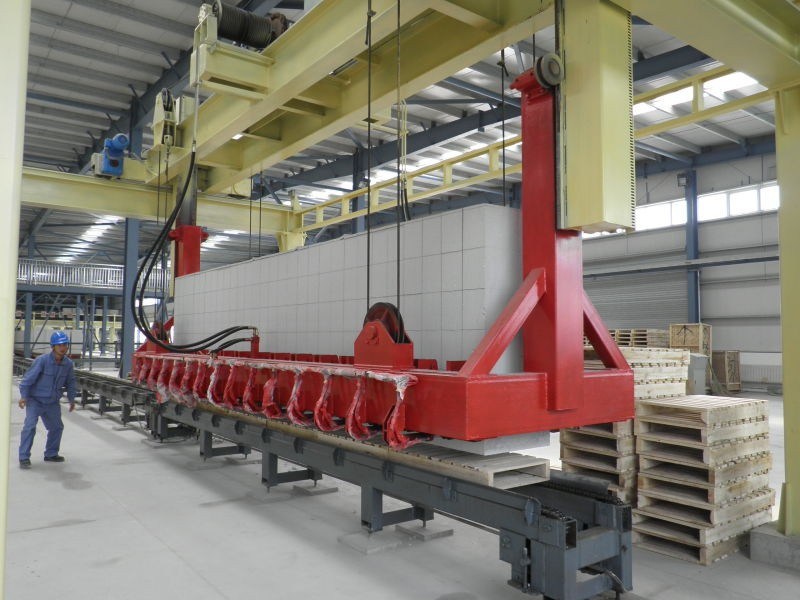Autoclaved aerated concrete (AAC), also known as autoclaved cellular concrete (ACC) or autoclaved lightweight concrete (ALC),[1] was invented in the mid-1920s by the Swedish architect and inventor Johan Axel Eriksson.[2][3] It is a lightweight, precast building material that simultaneously provides structure, insulation, and fire and mold resistance. AAC products include blocks, wall panels, floor and roof panels, and lintels.
It has been refined into a highly thermally insulating concrete-based material used for both internal and external construction. Besides AAC's insulating capability, one of its advantages in construction is its quick and easy installation, for the material can be routed, sanded, and cut to size on site using standard carbon steel bandsaws, hand saws, and drills.
Even though regular cement mortar can be used, 98% of the buildings erected with AAC materials use thin bed mortar, which comes to deployment in a thickness of inch. This varies according to national building codes and creates solid and compact building members. AAC material can be coated with a stucco compound or plaster against the elements. Siding materials such as brick or vinyl siding can also be used to cover the outside of AAC materials.
AAC has been produced for more than 70 years, and it offers advantages over other cementitious construction materials, one of the most important being its lower environmental impact.

AAC's improved thermal efficiency reduces the heating and cooling load in buildings.
AAC's workability allows accurate cutting, which minimizes the generation of solid waste during use.
AAC's resource efficiency gives it lower environmental impact in all phases of its life cycle, from processing of raw materials to the disposal of AAC waste.
AAC's light weight also saves cost & energy in transportation.
AAC's light weight saves labour
Raw materials
Unlike most other concrete applications, AAC is produced using no aggregate larger than sand. Quartz sand, lime, and/or cement and water are used as a binding agent. Aluminum powder is used at a rate of 0.05%-0.08% by volume (depending on the pre-specified density). When AAC is mixed and cast in forms, several chemical reactions take place that give AAC its light weight (20% of the weight of concrete) and thermal properties. Aluminum powder reacts withcalcium hydroxide and water to form hydrogen. The hydrogen gas foams and doubles the volume of the raw mix (creating gas bubbles up to 3mm ( inch) in diameter). At the end of the foaming process, the hydrogen escapes into the atmosphere and is replaced by air.
When the forms are removed from the material, it is solid but still soft. It is then cut into either blocks or panels, and placed in an autoclave chamber for 12 hours. During this steam pressure hardening process, when the temperature reaches 190° Celsius (374° Fahrenheit) and the pressure reaches 8 to 12bars, quartz sand reacts with calcium hydroxide to form calcium silica hydrate, which accounts for AAC's high strength and other unique properties. After the autoclaving process, the material is ready for immediate use on the construction site. Depending on its density, up to 80% of the volume of an AAC block is air. AAC's low density also accounts for its low structural compression strength. It can carry loads of up to 8 MPa (1,160 PSI), approximately 50% of the compressive strength of regular concrete.[4]
Since 1980, there has been a worldwide increase in the use of AAC materials. New production plants are being built in the USA, Eastern Europe, Israel,China, Bahrain, India, and Australia. AAC is increasingly used by developers, architects, and home builders.

[edit]History
The material was perfected in the mid-1920s by Dr. Johan Axel Eriksson, an architect working with Professor Henrik Kreüger at the Royal Institute of Technology.[2][3] It went into production in Sweden in 1929 in a factory in Hällabrottet and became very popular. In the 1940s, the trade mark Ytong was introduced, but it was often referred to as "blue concrete" in Sweden due to its blueish tinge. This version of Ytong was produced from alum shale, whose combustible carbon content made it beneficial to use in the production process. The competing concrete brand Siporex produced in Tuzla, Bosnia, used other raw materials. "Ytong" acquired Siporex and today produces "Siporex" under "Ytong" brand in Tuzla, Bosnia factory. However, the slate deposits used for Ytong also contain uranium, which makes the material give off radioactive radon gas to the building. In 1972, the Swedish Radiation Safety Authority pointed out the unsuitability of a radon-emitting construction material, and the use of alum slate in the production of Ytong ceased in 1975. Ytong produced after 1975 has used raw materials without the uranium content.
Shanghai Qianyu Heavy Industry Machinery Co. Ltd. Is a professional manufacturer of autoclave aerated concrete equipment, autoclaved lime sand brick equipments and mining equipments
Qianyu is located at No. 398 Xiexin Road, Fengxian District of Shanghai, near to the outer ring expressway A30 and national highway G320, it is only 40 km away from Shanghai Pudong and Hongqiao International Airport, which has the advantage of strategic location and convenient traffic. Qianyu covers an area of 18, 600m2, including 10, 000m2 building area, and also has 70 sets processing equipments.
Through conversion mechanism, talent introduction, equipments investment, working with scientific research institutes, and carefully committed to new wall materials and equipments research and development, Qianyu has become a modern enterprise with advanced technology, excellent equipments, sandard management, good quality and first-class service. And our equipments have been sold to Indonesia, Kazakhstan, Saudi Arabia, Iraq, Iran, Russia India and many other countries.
We have more than 300 staffs, including 36 medium and high level technical experts. The super self-responsibility and social responsibility makes our products on top of the building materials equipments field.
Based on the honest belief, we sincerely cooperate with new and old friends, to promote the development of Chinese building material industry and building material equipments.


